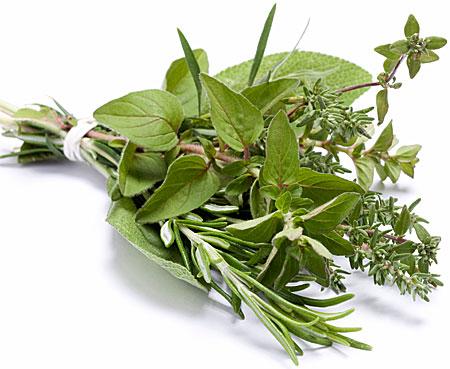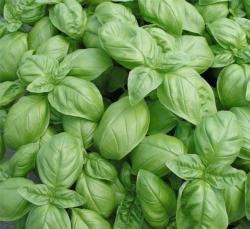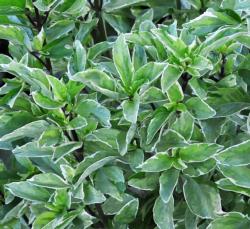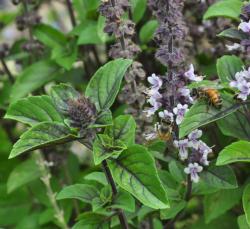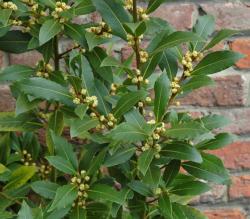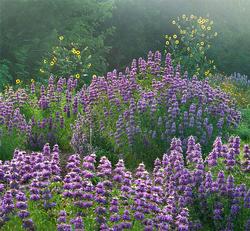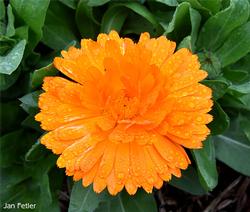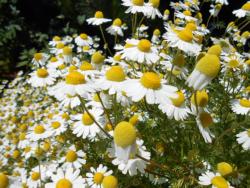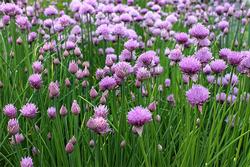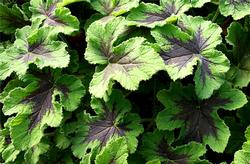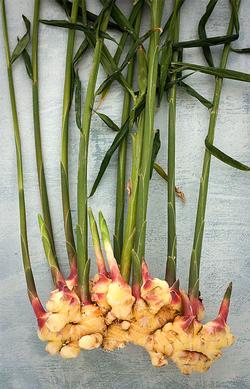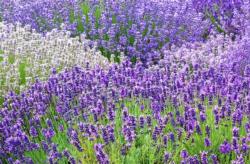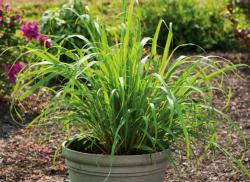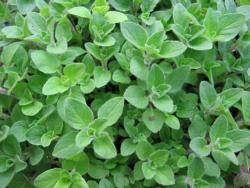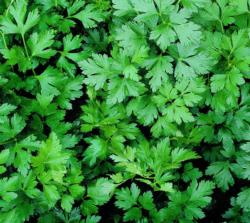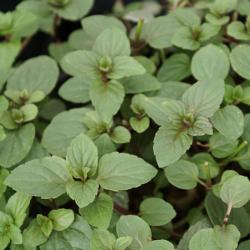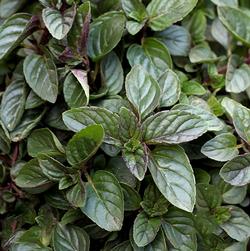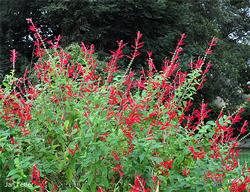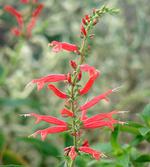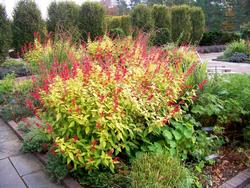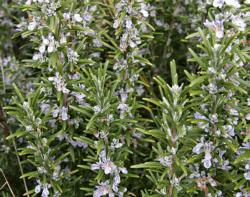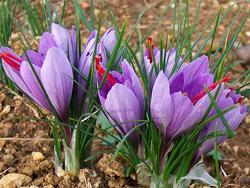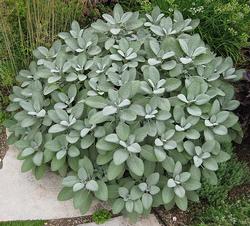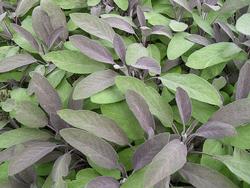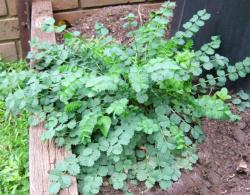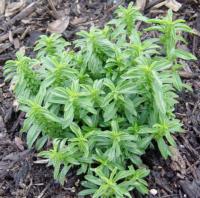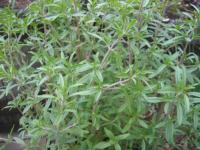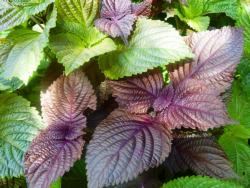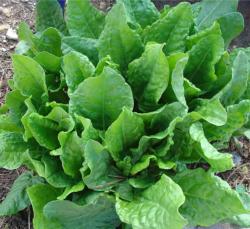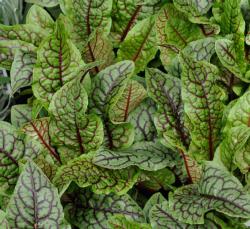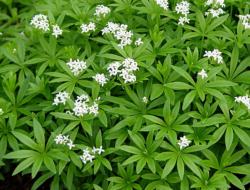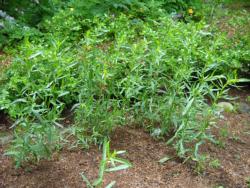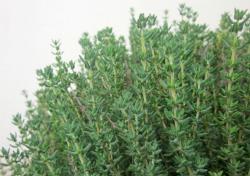Grow herbs!

The word “herb” comes from the Latin word “herba”, which means grass or green plant.
Most herbs are herbaceous, which means a plant without a permanent woody stem. However, the broad term of “herb” often includes flowers, vegetables, grasses, and even trees. Plants can look just as good in the perennial or shrub border as they do in the herb garden and most are very water thrifty.
Below on this page are some of our favorite herbs at the Fair Oaks Horticulture Center. There are so many more. For a complete list of herbs, landscape ideas and edible flowers, consider looking over these publications:
- Culinary Herbs (PDF)
- Landscaping with Herbs (PDF)
- Edible Flowers (PDF)
- Lavenders for California Gardens (PDF)
Most herbs are fairly problem free, but there are a few pests and diseases to watch for. The following links will take you to the UC Integrated Pest Management website (each opens in a new window):
Quick links
Basil | Bay Laurel | Bee Balm | Calendula | Chamomile | Chives | Geranium, Scented | Ginger | Lavender | Lemon Grass | Oregano | Parsley | Peppermint | Pineapple Sage | Rosemary | Saffron | Sage | Salad Burnet | Savory | Shiso/Perillia | Sorrel | Sweet Woodruff | Tarragon | Thyme
Herbs for Your Garden
Basil is a member of the tropical genus Ocimum which originated in Africa and domesticated in India. It is an annual that typically grows 8 to 24 inches tall, requires full sun, moderate watering and does best in rich soil.
Basil does well in our warmer climate but can’t tolerate the winter frost. It can be grown as an indoor plant in a south facing window with a minimum of 5 hours of sunlight or florescent lights 6 inches above the plants for 14 to 16 hours a day.
To grow it outdoors, basil is best started from seed (which germinates in 5 to 14 days) sown indoors in late March or early April and moved to the garden after danger of last frost has passed. There are many basil varieties.
Best used fresh. Pick the leaves when they are young, and always pick from the top to encourage new growth. Harvest before flowering. Prune basil to first leaf bud below the flower to encourage more leaf production.
Want to try something new? Basil 'Pesto Perpetuo' is a standout for its variegated leaves and good space neighbor because it takes up only about a foot in width in the bed as it grows to 3 to 4 feet in height. It's a great container plant. The most unique feature of 'Pesto Perpetuo' is that it does not flower or make seeds. All of its energy is focused on making flavorful leaves. Because there is no seed, a number of sources consider this plant a tender perennial and not an annual. Overwinter it indoors or take cuttings in fall to grow indoors.African Blue Basil is another basil that doesn't make seeds--but it makes plenty of flowers!
Native to Africa, it is a hybrid of camphor basil (Ocimum kilimandscharicum) and a small, purple-leafed variety of ordinary garden basil (Ocimum basilicum).
African blue basil blooms profusely starting in March and continues non-stop until November, when the first frost. Its flower stems can grow to 18 inches long and attract bees and other pollinators. Since African blue basil is sterile and will not go to seed, all its energy goes into producing flowers.African blue basil’s lovely flowers can be used for ornamental purposes as well as culinary. They perform well as cut flowers and in dry bouquets. Some people think that the camphor scent is too strong for cooking, but others think that it makes great pesto. It can also be used as garnish.
African blue basil requires a minimum amount of water and can tolerate poor soil. It grows both indoors and out, and prefers full sun but can tolerate partial shade. The lack of seeds is no problem to propagating African blue basil which can be done easily with cuttings. When taking a shoot, place it in water and roots will begin to grow in a few days.
Most gardeners treat all basils as annuals and buy new plants in spring after the last frost.
Look for basil in the FOHC Herb Garden’s Mediterranean aromatics bed along with other great herbs! For even more, download our Garden Note 115, Basil (PDF).
One of the culinary flavorings often used in soups and stews is the Mediterranean Laurus nobilis also known as sweet bay or Grecian laurel. The plant can be grown as a tree, multi-trunked shrub, or container plant.
Leaves can be harvested year round. Its leaves are rich with the heady, aromatic scent of the essential oil ceneole. Historically a garden and culinary favorite, ancient Greeks made garlands and crowns from the branches and leaves to honor bravery, victory and heroics. The commonly used phrases “resting on your laurels,” poet laureate and baccalaureate also originated from old Greek roots.
Sweet bay is a member of the Lauraceae family, which includes avocados, cinnamon, camphor and the California native bay laurel, Umbellularia californica (although more pungent than Laurus nobilis, can also be used in cooking).
Bay laurels grow well in Sacramento with some afternoon shade to protect from sunburn. Although not overly picky about soils, they do prefer well drained, slightly acidic locations. Small bay trees do well in pots due to their slow growth but can reach 20 to 40 feet tall in landscapes. Flowers are insignificant and berries are often overlooked. Although very water-wise, a deep watering every 2 to 3 weeks in the summer will help the tree maintain vigor. Trees can be subject to sooty mold.
Bee Balm
Monarda citriodora ‘Bergamo’
When we planted bee balm in the Mediterranean beds, we discovered that a few of us were calling the herb by different names! Monarda, bee balm, Oswego tea, and bergamot are all accurate names for the fragrant leggy plant with the bright firework-like flowers.
Bee balm is native to North America. It is considered a perennial but can be treated as an annual. It attracts both pollinating insects and hummingbirds. Plants can grow to a height of several feet and many varieties are known to spread. Bee balm is also susceptible to powdery mildew. On the plus side, bee balm is considered drought tolerant and deer resistant.
Bee balm prefers sun, but it will grow in partial shade. Propagation is by division and by cuttings. Although many remember the classic scarlet red bee balm (Monarda didyma), Monarda citriodora usually flowers in shades of pink.
Postscript: Our first bee balm died because it was planted in a location that wasn’t getting enough water. We will plant again in a different location.
Calendula
Calendula officinalis
Calendula is native to southern Europe and the eastern Mediterranean. It is a short-lived perennial that propagates itself easily from seeds, and has long been cultivated by gardeners for its many medicinal and culinary uses. Calendula flowers close in the dark, or when wet weather is likely to occur, so they can be used as a rough gauge weather forecaster.
Calendula is easy to grow in sunny locations, surviving in most soils if they are well-drained. Seeds germinate in 10 to 14 days. It can also be bought as a transplant. There are many varieties of calendula with colors ranging from bright yellows to red-orange tones. Plant height varies by variety. Tall varieties grow to a maximum of 2 feet, producing flowers that are typically 2 to 3 inches across or more. Pinching young plants encourages compact bushy growth. It is attractive to bees and butterflies and has a spicy aroma.
Calendula produces both male and female flowers that exist on the same plant. It has a long growing season, and can produce flowers profusely if deadheaded as soon as flowers begin to wilt. It fades in extreme heat but can rebloom in fall if cut back when it goes limp.
It is susceptible to cucumber mosaic virus and powdery mildew. Tall Calendulas make good cut flowers. Both the leaves and flowers of calendula are edible. Its petals give color to salads. It’s a replacement for saffron, and the leaves can be eaten raw or cooked, but tend to be bitter.
Calendula is grown in the herb and vegetable gardens at the Fair Oaks Horticulture Center.
German chamomile is an annual of the composite family Asteraceae. It prefers slightly alkaline soil, full sun to partial shade and low water.
Plant seeds early in the spring when soil temperatures are about 55°F. Scatter the tiny seeds directly on the soil surface where you want them to grow. Gently tap down with the flat side of a hoe or a gloved hand. They will germinate in 7 to 10 days. Thin plants to 1 to 2 inches apart. Once plants reach 1 to 2 inches in height, transplanting is not advised. Young seedlings will withstand a mild frost. They will reach 1 to 2 feet in height.
Small white daisy flowers with a pleasant pineapple flavor appear in late spring. They attract beneficial insects and self-seed so you have a steady supply next year.
Chives
Allium schoenoprasum and Allium tuberosum
Chives are bulb-forming perennial herb found across much of Europe, Asia and North America. It grows 12 to 20 inches tall and wide. One or two plants will provide plenty of tasty additions to menu items. They make an attractive border plant and have beautiful pink or white flowers that bloom in April and May. Chives are hardy in zones 3-10.
There are two types of chives, onion chives (Allium schoenoprasum) and garlic chives (Allium tuberosum). Onion Chives have a mild onion flavor and pink flowers. Chive flowers and the foliage are edible. The less common Garlic Chives have a mild garlic-like flavor and a white flower.
Chives prefer a sunny location but aren’t fussy about soil, and they tolerate neglect. In fact, you need to pick flowers before they go to seed because this plant can be invasive. Use the flowers in arrangements where they last a week or more.
Harvest leaves once plants are established.
Geranium, Scented
Pelargonium quercifolium
‘Chocolate Mint’ scented geraniums are perennials that have a minty scent, but the “chocolate” refers to the dark brownish red blotch that runs through the center of the oak-shaped leaves.
Like many scented geraniums in our area, it may die back in the winter, only to return in the spring. The pink flowers are secondary to the variegated foliage. It needs to be trimmed regularly so it doesn’t get rangy. It is easily propagated from cuttings. It will tolerate some shade.
Scented geranium flowers are also edible, and can be used in cooking. Be aware that the flowers have a more delicate flavor when compared to the leaves.
According to the Old Farmer’s Almanac, the main difference between herbs and spices is that herbs come from the leafy part of the plant, whereas spices come from all of the other parts: seeds, bark, roots, etc. That means edible ginger is a spice since we use the roots.
Throughout history, ginger has had many uses as both a medicinal and culinary spice. Some varieties of ginger are highly prized for their ornamental flowers and for fragrance. Turmeric, another spice, is also from the Zingiber family.
Ginger is a tropical perennial, but with the right amount of care it can thrive in our Northern California climate. Ginger prefers a sheltered area with partial shade. It loves rich soil and needs to be watered regularly. It is not a drought tolerant plant but also doesn’t like wet feet. Although the Herb Team bought Zingiber officinale ‘Tahitian Sunset’ locally for the FOHC herb beds, it is possible to grow ginger with a rhizome purchased at a grocery store. Make sure the rhizome is plump, and then cut it like a potato into 2 to 3-inch pieces for planting, making sure that each section has a “bud.” Let the pieces dry. Plant with the bud upward in one inch of soil and space the pieces approximately 15 inches apart.
Ginger can be planted in spring after fear of frost, and gently harvested around 4 months later. Mature plants reach 3 to 4 feet tall. It can be fully harvested once the foliage dies back. For more on propagating ginger, visit SFGATE Home Guides.
Lavender is a perennial shrub that enjoys full sun, well-drained soil and low water. Space plants 1 to 2 feet apart. Depending on variety, they will reach 2 to 4 feet in height. Plants attract butterflies and other beneficial insects.
While it can be used as a culinary herb, it most often used as a scent. For culinary purposes, look for sweet-tasting varieties such as English lavenders (Lavandula angustifolia 'Munstead,' 'Melissa' or 'Lady') or ask an herb grower for recommendations. Our favorite for recipes is ‘Folgate’ lavender--it doesn’t give food that “soapy” taste.
Lavenders can be grown from seed or cuttings taken in spring or fall. For drying, harvest buds just as flowers are about to open. Prune lavender after flowering to keep plants from becoming woody.
There are numerous varieties featuring different flower colors and heights. English varieties (Lavandula angustifolia) mentioned above, are also used for scent. French hybrids (Lavandula x intermedia) are considered number one for scent. Varieties such as ‘Provence’ or ‘Superior’ do well in our region. Spanish varieties (Lavandula stoechas) have a distinctive flower form. ‘Otto Quast’ is a UC Davis Arboretum All-Star selection.
Deer resistant.
Lemon Grass
Cymbopogon citratus
When fall weather arrives, it is easy to imagine sitting down to a warm bowl of Thai coconut soup or a hearty curry stew. Lemon grass is a primary ingredient in these and many other Asian comfort foods. The leaves can be used to make a flavorful tea. Lemon grass has graced the Herb Garden at Fair Oaks Horticulture Center for many years, and we always get questions about how to grow and harvest it.
With its lush, pampas grass-like appearance, it is hard to believe it is even an herb. Lemon grass is easily grown from cuttings taken from the base of the plant. Make sure to plant the cuttings with plenty of space because the plants get big fast. Lemon grass prefers soil with good drainage. It is susceptible to root rot.
Considered a tropical herb, Lemon grass is grown as a tender perennial. In Sacramento County, many gardeners grow lemon grass in containers so they can move and protect the plant from frost. Lemon grass does well in containers, provided the container is solid. Lemon grass is a large willowy plant that can grow up to three to four feet high. It can quickly outgrow its container and become top heavy.
Lemon grass prefers full sun, but will tolerate some shade. At FOHC we grow our lemon grass under a tree canopy from the Water-Efficient Landscape, and it is doing well. Lemon grass can be harvested throughout the growing season. Simply pull at the base with a trowel to remove the outer shoots. Like lemon verbena, lemon grass leaves will turn brown with the first serious frost. In early spring vigorously cut it back to about a foot in height. The roots are trimmed around the base using a sharp spade. Very quickly it presents new shoots.
Oregano 'Hot and Spicy'
Oreganum vulgare
'Hot and Spicy' is noted for its intense, somewhat spicy flavor. It is a sprawling, rhizomatous perennial that typically grows to 12 to 18 inches tall and spreads to 18 inches wide or more. Dark green leaves (to 1 inch long) are strongly aromatic. Tiny, white to purple-pink, two-lipped flowers (typical of the mint family) rise above the foliage in July and August in terminal or axillary spikes. Flowers are conspicuous but not of high ornamental value. Leaves are used either fresh or dried to flavor food dishes, particularly in Italian and Mexican cuisine.
Culture: Easily grown in average, dry to medium moisture, well-drained soils in full sun. It does very well in gritty, sandy loams. Good heat and drought tolerance. It's best to shear plants back regularly before flowering to keep the plant tidy and to induce growth of new leaves.
Noteworthy characteristics: Origanum is a genus of about 20 species of herbaceous perennials, and deciduous and evergreen subshrubs. They are native to the Mediterranean and Southwest Asia. Some are used as culinary herbs.
The genus name probably comes from the Greek words oros meaning mountain and gamos meaning beauty, in reference to the physical appearance of this plant which is sometimes native of mountain areas where it is appropriately referred to as “beauty of the mountain.”
What is the one herb that goes into just about all of your stews, soups, sauces, dressings and seasonings recipes? That modest but ubiquitous herb, parsley, Petroselinum crispum! It’s a natural breath sweetener too, due to its high chlorophyll content. What better herb to grow in your garden for a fresh, ready supply when you need it?
Parsley grows in two distinct varieties you’ll probably recognize—curled parsley (Petroselinum crispum var. crispum) is the go-to garnish on many dinner plates, but you’ve probably also used Italian flat leaf parsley (P. c. var. neapolitanum) in your recipes. Italian flat leaf parsley is said to have a stronger flavor that holds up better in cooking than curly parsley, but both are lush and vigorous year- round plants for your garden.
Parsley is a hardy plant in all Sunset zones and USDA zones of 7 or greater (that’s Sacramento County), frost-tolerant and a great winter garden plant for herb and flower beds, borders, or containers with other winter color.
Parsley needs cool weather to germinate, so plant in spring and fall to ensure a fresh supply throughout the year. The herb prefers full sun to part shade, with afternoon shade in our hot Central Valley. Italian flat-leafed parsley is more tolerant of hot weather than curly parsley, which can experience slow growth during the hottest days of summer. It grows best in rich, moist, well- draining soil. Soak the seeds in warm water for 24 hours before planting to encourage germination. Be patient—they may not come up for several weeks, even with soaking. Thin seedlings to 12 to 18 inches apart for flat leaf parsley, 6 to 8 inches apart for the curly variety. Both varieties will grow to 1 to 2 feet tall.
Keep soil moist after planting until plants are well-rooted. Once established, the plant needs moderate water (weekly). In containers, irrigate whenever the soil is dry. Plants can rot if mulch is piled too deeply against stems, so give them a little breathing room. Watch out for whiteflies, a common pest.
Pick leaves any time in the growing season once the plant reaches a height of about 8 inches. Cut stems back to the base of the plant. It is best used fresh, as parsley loses flavor when dried.
Parsley is a biennial, growing during its first season and blooming during its second season. White flowers appear during the second summer, causing leaf flavor to turn bitter – that’s the time to pull plants and start over. Many gardeners prefer to grow parsley as an annual.
Peppermint was first cultivated in the mid-1700s near London and is a hybrid between watermint and spearmint. Now you can find it growing almost anywhere in the world.
Peppermints are fast-growing, herbaceous perennials that do well in Sacramento. They can tolerate light frost and are generally pest-free. They grow between 18 to 36 inches tall. Peppermint loves rich soil with good drainage and it is often found naturalized by ponds and rivers and will grow in partial sun.
There are two main cultivated varieties. White peppermint is light green and has a mild flavor, while black peppermint is deep purple and green and has a higher oil content. Small, lavender-colored flowers bloom in mid to late summer.
It does have a tendency to spread, but it’s not as invasive as some of its other mint relatives. Because it grows from underground roots (rhizomes), many gardeners choose to plant in containers or confined beds to prevent the roots from spreading.
To prolong the life of the plant, move it to a new location every 3 to 4 years or take cuttings and start new plants when it starts to weaken or become spindly. Cuttings root quickly in a jar of water. Peppermint flowers are nectar producers and attract a variety beneficial insects.
Chocolate Mint (Mentha x piperita f. citrata 'Chocolate') is a variety of peppermint that has a distinctive chocolate scent and is used in teas and cooking. It is an attractive dark-leafed, low growing perennial that tolerates shade. Once established, it can be very invasive. It is best grown in a container or a confined environment. Mint is easily propagated from cuttings. It is not considered drought-tolerant and prefers moderate watering. It is, however, a hearty herb and can survive “dry spells.”
Mint flowers are also edible, and can be used in cooking. Be aware that the flowers have a more delicate flavor when compared to the leaves.
Pineapple Sage
Salvia elegans
Pineapple sage is a member of the mint (Lamiaceae) family. It is hardy in zones 8-11 and does well in Sacramento County.
Pineapple sage blooms late in summer and into spring where winters are mild. This mint produces bright colored tubular flowers ranging in color from red to salmon, to orange. Hummingbirds and butterflies love it. Both leaves and flowers are edible and are nice dried for potpourris. It gives off a scent reminiscent of pineapple when its leaves are rubbed.
Give it full sun with some afternoon shade, consistent moisture, and good drainage. It wilts and drops leaves if allowed to dry out. It grows to 5 feet tall by 3 feet wide, and will grow in containers.
Pineapple sage has few pests other than aphids, mealy bugs, and spider mites, and deer tend to avoid it. Plants can be started from seed or cuttings, and root easily. Pinch young plants to create compact and bushier growth. Pruning old woody stalks to the ground in January encourages new shoot growth and helps keep the plant to a manageable size.
Cultivars include ‘Frieda Dixon’ (salmon pink flowers), ‘Golden Delicious’ (red flowers with chartreuse leaves), ‘Honey Melon’ (a smaller, summer bloomer), ‘Scarlet Pineapple’ (most prolific bloomer), and ‘Tangerine’ (another smaller, earlier blooming variety with a more citrusy scent).
Rosemary
Savia rosmarinus (was Rosmarinus officinalis)
When the conversation drifts to edible landscaping, how can you not lavish love on rosemary ‘Tuscan Blue’? Tough, drought tolerant, and a dazzling, evergreen beauty, ‘Tuscan Blue’ doubles as one of the best culinary herbs. Snip the piney-tasting, needle-like leaves for any number of scrumptious dishes.
‘Tuscan Blue’ is a versatile choice for the garden with its upright growth and showy, lavender-blue flowers. It can be used as a foundation planting, a hedge, a screen, in containers or mixed borders, as a stand-alone stunner, a rock garden star and is a favorite for topiaries. It’s deer resistant and attracts butterflies, bees and birds. Blooms appear in spring, linger into summer and sporadic blooming can break out the remainder of the year.
Growth is taller than spread – 5 to 6 feet tall, if you allow it, and 3 to 5 feet in width – but it is easily shaped or pruned if desired. Prune after the main bloom period. Plant in full-sun and well-drained soil. If soil conditions aren’t conducive to ‘Tuscan Blue,’ plant in a large container. Water regularly the first year, until established. In winter, ‘Tuscan Blue’ can survive temperatures as low as 15 degrees.
Want a rosemary that stays small? ‘Herb Cottage’ dwarf rosemary has been showing up locally in containers and in low borders. Salvia rosmarinus foresteri was first cultivated in the National Cathedral’s garden in Washington D.C. It has lovely blue flowers and an upright form.
'Herb Cottage' reaches no more than 2 feet in height and is well suited to potting. Its smaller size is a big selling point for gardeners with limited space. It’s used like any other rosemary.
Rosemary can be grown as an indoor plant in a south facing window with a minimum of 5 hours of sunlight or florescent lights 6 inches above the plants for 14 to 16 hours a day.
Often called Saffron crocus or Autumn crocus blooms in the fall. When we think of fields of saffron, we think of faraway lands such as India or Greece. In reality, saffron, the most expensive spice in the world, can grow on all habitable continents.
Last summer we introduced a few corms (bulbs) of saffron (Crocus sativus) to the Mediterranean herb beds at FOHC. Watch Master Gardeners Maria Schiffler and Vivian Seller’s 90-second video: Planting Saffron Crocus at the Fair Oaks Horticulture Center.
Plant as soon as you receive the corms or early fall. Within weeks of planting the corms, spikey leaves will appear like other crocus species. Saffron flowers bloom quickly after a show of leaves. It takes a lot of corms of crocus to provide a suitable harvest.
Fall rains help nourish the soil. By November it’s time to harvest the flowers. The only part used is the orange stigma. Three stigmas are borne in the center of each purple, cup-shaped bloom. The best time to harvest the stigmas is mid-morning on a sunny day when the flowers have fully opened and are still fresh. Allow the stigmas to dry at room temperature then store.
We just can't get enough of sage in the garden! Sages are low maintenance perennial herbs that grow in part or full sun. They are sturdy, hardy, prolific, and drought tolerant. They attract hummingbirds, bees, and butterflies.
The Latin name salvia comes from salveo, which means “I save” or “I heal.” In 1737, Benjamin Franklin invented the art of nature printing from leaf casts, via a copper plate press, for transferring a sage leaf image onto the back of paper money bills, a technique intended to thwart counterfeiters of paper money bills.
In the FOHC Herb Garden Mediterranean bed, varieties we love include:
| Salvia officinalis 'Berggarten' - This highly valued culinary sage produces large, round gray-green leaves that are more flavorful than common sage. Bloom time: late spring to mid-summer, shy-bloomer, produces few short spikes of violet/lavender blue flowers. It makes an outstanding edging plant, growing into a low, compact mound to only 12 inches tall and 18 inches wide. |
|
| Salvia officinalis 'Purpurea' - Referred to as common sage this a compact variety that stays under 2 foot tall and wide forming a dense mound of smoky grey and purple leaves-perfect for adding contrast to the edge of a bed or container. In summer, 2 foot tall flower spikes support lovely hummer-attracting purple blooms lasting several months. |
Salvia is the largest genus in the mint family. Foliage is often fragrant, stems are square, and two-lipped flowers are produced in whorls on flower stalks, which may be crowded and appear like a dense spike. Flowers bloom in many colors including white, yellow, pink, red, lavender, blue, and purple.
Sages grow best in areas with full sun and good air circulation. They thrive in well- drained, sandy, loamy soil, and prefer a pH between 6.0 and 7.0. Provide rich, well-draining soil for a happy plant and to prevent root rot. Wait until the soil is dry to give it a thorough watering. Resist the temptation to over-fertilize; the sage might grow a little faster, but its flavor will be less intense.
Sage can be propagated by seeds, but more easily by cuttings, layering, or root division of older plants. Or look for transplants at your nursery or garden center.
Harvest by snipping leaves. Prune lightly during the growing season to shape plants. Pruning before bloom will delay flowering. After the second year the plant needs to be trimmed in spring to avoid the center becoming woody.
Although many of the perennial herbs at Fair Oaks Horticulture Center (FOHC) die back in the winter, salad burnet is a cheerful reminder that some herbs are still available for use on even the coldest days. Its feathery leaves taste much like cucumber. The young leaves are often tossed in salads, soups and vinegars. It has been rumored that the original colonists brought salad burnet over from Europe. It is a hearty herb, with virtually no issue with pests or diseases.
Salad burnet is an easy plant to grow and self-seeds easily. We have grown two salad burnets at FOHC – Sanguisorba officinalis, which has medium green leaves, and Sanguisorba minor, which has grey-green leaves. Only the Sanguisorba minor remains today. It is growing in a pot in the Mediterranean beds. The plant itself has a clumpy low growing habit and dainty serrated oval leaves. In late spring the plant shoots out long stemmed pink/purple clover-like flowers that are also edible. Because the plant self-seeds so readily, flowers are quickly removed after they are spent. Salad burnet needs ongoing pruning during the summer to encourage new growth.
Although our salad burnet is growing in full sun, it will tolerate some shade. It can readily be grown from seed, and prefers well-drained soil. It is considered drought tolerant. The mature plant reaches up to 18 inches (before flowering). Salad burnet’s “four season” status and its feathery shape make it an asset for any herb garden.
Winter and Summer Savory
Satureja montana and Satureja hortensis
It is fun to have a culinary herb name that actually says what it is, which is the case with winter savory (Satureja montana) and summer savory (Satureja hortensis). Both herbs have been synonymous with beans and meat cookery for centuries.
Winter savory is a perennial and has a stronger flavor than summer savory, which is an annual. Both herbs are fairly low growing, up to 18 inches tall, and have delicate white or lilac colored flowers that attract bees. For border plantings consider Satureja montana ‘Nana’ which is a winter savory dwarf groundcover cultivar, which grows to less than a foot tall.
The savories are considered Mediterranean herbs. They require around 6 hours of sun each day and prefer well-drained soil. Both are hardy and drought tolerant. Winter savory can become woody and needs regular pruning to encourage new growth. Likewise, summer savory can become “floppy” and may need pruning as well.Winter savory can be propagated by division or through soft wood cuttings; summer savory is generally grown from seed. Look for transplants at your nursery or garden center.
Harvest as needed throughout the growing season. Even the flowering shoots can be used either fresh or dried.
Shiso or Perilla
Perilla frutescens
Shiso is an annual member of the mint family Lamiaceae. It is generally known in Europe as Perilla, where it is used as an ornamental. Its striking red-purple or green leaves resemble coleus. However, in both Japan and Korea shiso is used in cooking. In Japan, shiso can be found in norimaki sushi rolls and in Korea it is often used in a marinade.
The taste of the red-leaf varieties is somewhat astringent or bitter. The green leaves have more of a cinnamon taste making them a favorite for recipes.
Shiso can be grown from seed in the spring or bought as young plants at Asian markets or herb nurseries. Seeds must be soaked 24 hours before planting. Like basil, shiso is frost tender, thrives in sun or partial shade, and likes well-drained soil. Both red-purple and green varieties have lovely spiked flowers that reseed. Plants can get big—up to 3 feet tall if grown as an ornamental.
Look for shiso in the FOHC Herb Garden’s Asian aromatics bed.
Sorrel
Rumex acetosa and Rumex sanquineus
Sorrel is a hardy perennial herb that winters well in Sacramento, and is especially robust in the spring. At the Fair Oaks Horticulture Center we grow two types of Sorrel - French Sorrel (Rumex acetosa) and Red Veined Sorrel (Rumex sanquineus).
Sorrel is an edible herb that has a long culinary history. Anyone who has tasted Sorrel will not be surprised that the word “sorrel” translated into French is “sour.” When harvesting, be sure to pick the young tender leaves for uncooked dishes. The older leaves can be used in soups and sauces, but be aware that the bright green leaves will turn grey when cooked. French Sorrel is generally less bitter than the Red Veined Sorrel. The Red Veined Sorrel with its bright colorful leaves is often grown strictly as an “ornamental.”
Sorrel can be grown from seed, but it will take a season to become established. Once established it is drought tolerant. Sorrel will tolerate shade and prefers well drained soil. Sorrel can become aggressive. At the FOHC we grow our Sorrel in containers, and we thin the plants on a regular basis. We also remove the flower spikes that shoot up during the growing season. Powdery mildew and snails are the major issues we have with this herb. Unsurprisingly, the snails prefer the less bitter French Sorrel.
For gardeners desiring a ground cover that thrives in full or partial shade, does not require frost protection, and resists pests and disease, Galium odoratum or sweet woodruff is an attractive option. Native to Europe, North Africa, and Siberia, this perennial evergreen is a woodland herb growing to a height of 6 to 12 inches.
The New Sunset Western Garden Book describes sweet woodruff as having slender, square stems encircled every inch or so by six to eight emerald green leaves and with clusters of tiny white flowers appearing above the foliage in late spring and summer. When dried, the leaves become aromatic, releasing a sweet smell reminiscent of mown hay and vanilla.
The Cornell Book of Herbs and Edible Flowers notes that sweet woodruff likes acid soil and does not require fertilizing, but should be cut back after blooming to encourage bushiness. This source also emphasizes that sweet woodruff, can be greedy for garden space, spreading readily enough to be called invasive.
In the Sacramento area, sweet woodruff is a moderate water user. Propagation is by division or stem cuttings in the spring.
Traditional uses of sweet woodruff: in Germany the dried stems and leaves are added to Rhine wine to make the ‘Maibowle” or May wine. In previous eras, the dried stems and leaves were added to sachets for scenting linen drawers.
Tarragon
Artemisia dracunculus var. sativa
One of the herbs in our Mediterranean beds at FOHC is French tarragon. This culinary herb is known for its distinct “anise” flavor, needle-like leaves, and rangy growth. Like its Mediterranean neighbors, French tarragon dislikes wet feet and prefers full sun. It will tolerate a little shade and will grow in most well-drained soils. It is a perennial in Sacramento and it will die back after first frost. A little bit of mulch will protect it over the winter.
An unusual aspect of French tarragon is that it doesn’t flower. If you have tarragon that is flowering it is likely that you have Russian tarragon in your garden, which is inferior in flavor to the French variety. Because they now share the same Latin name, it is important to be careful when purchasing French tarragon at a nursery.
French tarragon can be divided in the spring, but be aware it has shallow roots. Once established, it can grow up to three feet. It is generally disease and insect free.
This evergreen perennial prefers rich soil, low water and full sun to part shade. Space plants 1 foot apart. They reach a height of 8 inches and make a lovely ground cover or border plant.
There are a dizzying number of varieties of thyme grown for ground cover (20+) or culinary uses (10+). Familiar ground cover ornamentals are woolly thyme and creeping thyme. Common culinary varieties include English thyme, silver thyme and lemon thyme. Check local nurseries for what’s new.
Plants will root where stems touch soil making an expanding mat. Harvest leaves before blossoms open for best flavor.
Thyme can be grown as an indoor plant in a south facing window with a minimum of 5 hours of sunlight or florescent lights 6 inches above the plants for 14 to 16 hours a day.
